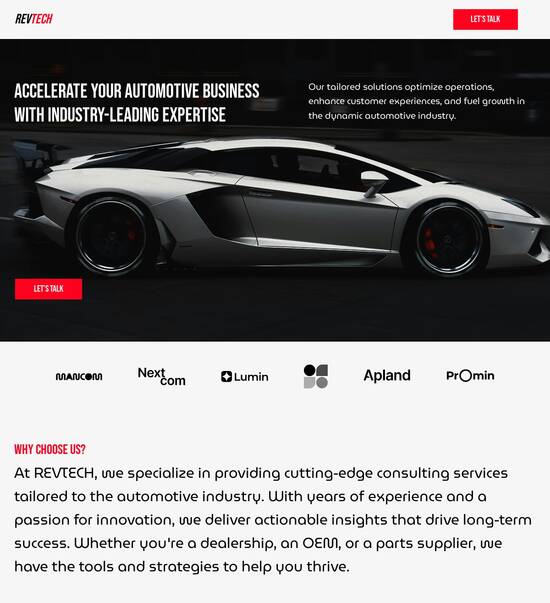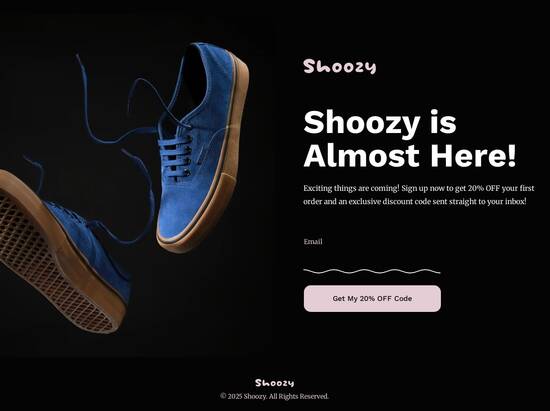
Bootstrap optimized archive page template
Explore Similar TemplatesAbout template
Supercharge your archive page with Bootstrap for outstanding performance! Learn more today.
Recommended templates

Easy to build without coding
With the intuitive drag-and-drop builder, anyone on your team can create high-converting pages without any knowledge of code or design. Make enhancements to your landing page with custom widgets using Javascript, HTML/CSS, or third-party scripts.

Multiple layouts for any industry and goal
Select from 500+ landing page layouts built to boost conversions across industry-specific scenarios. Customize them by adjusting fonts, adding images, and generating on-brand content with the AI assistant. Quickly scale with Instablocks® and Global Blocks that you can save, reuse, and update globally.

Loads fast and looks polished on any device
Every template is responsive, which means they present professionally on any device and load blazingly fast with our Thor Render Engine. You can also power them up with Google AMP technology to deliver an unparalleled mobile experience and drive higher conversions.

Robust analytics & experimentation
Get real-time updates and reporting across all your devices, showing the number of visitors, conversions, cost-per-visitor, and cost-per-lead. Launch AI-powered experiments, run A/B tests, and use heatmaps to analyze user behavior, then optimize your landing page to maximize conversions.







Easy to build without coding
With the intuitive drag-and-drop builder, anyone on your team can create high-converting pages without any knowledge of code or design. Make enhancements to your landing page with custom widgets using Javascript, HTML/CSS, or third-party scripts.
Multiple layouts for any industry and goal
Select from 500+ landing page layouts built to boost conversions across industry-specific scenarios. Customize them by adjusting fonts, adding images, and generating on-brand content with the AI assistant. Quickly scale with Instablocks® and Global Blocks that you can save, reuse, and update globally.
Loads fast and looks polished on any device
Every template is responsive, which means they present professionally on any device and load blazingly fast with our Thor Render Engine.
Robust analytics & experimentation
Get real-time updates and reporting across all your devices, showing the number of visitors, conversions, cost-per-visitor, and cost-per-lead. Launch AI-powered experiments, run A/B tests, and use heatmaps to analyze user behavior, then optimize your landing page to maximize conversions.
All the features you need to build lead-generating landing pages
Explore more featuresLearn how to build top-performing landing pages for any goal
FAQs
Leading the way in building high-performing landing pages





A step-by-step guide for using Instapage as your ultimate landing page and CRO platform
If you're looking to enhance your digital marketing campaigns, Instapage is your go-to solution for powerful landing page creation and conversion rate optimization (CRO). With its user-friendly interface, marketers in various sectors such as education, tech, and finance can accelerate their efforts and maximize ROI. This guide will walk you through the essential steps to leverage Instapage effectively.
Understanding the basics of Instapage
Instapage empowers marketers to build high-converting landing pages without any coding skills. With over 100 templates and customizable Instablocks, you can easily adapt your pages to suit your brand needs. This flexibility is crucial for businesses looking to capture leads and drive targeted traffic.
Step 1: Choosing the right template
Start by selecting a template that resonates with your campaign goals.
- Consider your target audience: Ensure the design appeals to your specific market segments.
- Focus on conversion elements: Choose templates that include essential lead generation components.
- Adaptability: Look for templates that can be customized to maintain brand integrity.
Step 2: Optimizing landing pages for conversions
Next, utilize Instapage's built-in tools to optimize your landing pages.
- A/B Testing: Regularly conduct tests to compare different elements and enhance the performance of your pages.
- Heatmaps: Use heatmaps to analyze user behavior on your site to identify areas for improvement.
- Analytics Dashboard: Track and evaluate the effectiveness of your campaigns through Instapage's comprehensive analytics.
Step 3: Personalizing your marketing messages
Personalization is a key driver for campaign success. Instapage allows you to customize content based on user data.
- Dynamic text replacement: Automatically adjust text based on user query to improve relevance.
- AdMaps: Align specific ads to dedicated landing pages for a seamless user experience.
- Audience-level metrics: Utilize detailed tracking to assess individual audience performance.
In conclusion, the power of Instapage lies in its ability to create customizable and optimized landing pages tailored to your audience.
Ready to boost your marketing campaigns? Dive into Instapage today and start crafting high-converting landing pages that drive results.
Exploring Bootstrap optimized archive page templates for enhanced web design
Understanding archive page templates
Archive page templates are essential components of web design that serve to compile and exhibit a collection of content, typically in an organized and user-friendly manner. They can function as a repository for blog posts, articles, products, or other forms of content that users may seek. The importance of these templates lies in their ability to enhance user navigation, allowing visitors to efficiently locate and interact with the content they are interested in.
In various industries, archive templates prove essential. For example, in e-commerce, they help users to browse through numerous products without overwhelming them. In educational contexts, these templates may showcase resources or articles, while in the marketing sector, they can serve to display case studies or blog entries. Ultimately, a well-structured archive page can significantly elevate user experience, making it a critical consideration for any web project.
The fundamentals of Bootstrap
Bootstrap is a prominent front-end framework that simplifies the web development process, providing developers with pre-styled components and a responsive grid system. Its design philosophy revolves around minimizing the time needed to create responsive websites while ensuring a consistent look across various devices. With its robust features, Bootstrap continues to gain traction among web developers for both personal and business projects.
Fluid grid system: This is a key feature that ensures your website adjusts beautifully to different screen sizes, accommodating mobile, tablet, and desktop users.
Built-in CSS classes: Bootstrap offers a wide array of pre-defined CSS classes that streamline styling processes, allowing developers to focus more on functionality.
JavaScript components: Bootstrap comes with a library of JavaScript components such as modals, dropdowns, and carousels, enhancing site interactivity with minimal effort.
These core features make Bootstrap a preferred framework for creating archive pages. By leveraging the grid system, developers can effortlessly arrange their content in a visually appealing format that is also functional and user-friendly.
Crafting a Bootstrap optimized archive page template
Creating an archive page template using Bootstrap involves several key considerations aimed at maximizing user experience. First and foremost, the layout must be organized and intuitive. Users should be able to quickly scan through the content without feeling overwhelmed by clutter or ambiguity. It's essential to embrace user experience principles tailored specifically for archive pages, ensuring that content is easily discoverable and readable.
To start building a Bootstrap optimized archive page, follow these steps:
Setting up the Bootstrap environment: Download Bootstrap files or incorporate them through a CDN within the HTML document head.
Defining the overall structure with HTML: Create the skeletal structure using appropriate HTML elements with semantic meanings.
Implementing the fluid grid system for responsive layouts: Use the Bootstrap grid system to align your content responsively.
Styling with CSS to create visually appealing designs: Customize Bootstrap's styles using your own CSS for further personalization.
Laying out an engaging archive page
A successful archive page layout prioritizes usability and aesthetics. Following best practices in layout design is crucial. Content should be arranged hierarchically to guide users naturally through the information without distractions. Moreover, using whitespace effectively can enhance readability, making the content more approachable and less overwhelming.
Header and footer designs: A consistent header and footer provide essential tools like logos, navigation links, and contact information, improving overall navigation.
Pagination controls: Incorporate pagination to break down long lists into manageable sections, allowing users to navigate through content easily.
Search and filter functionalities: Providing filters or search bars ensures users can find specific items quickly without having to scroll through extensive lists.
Overall, ensuring a well-structured layout on your archive page not only boosts usability but also promotes a pleasant browsing experience for your audience.
Enhancing user interaction with JavaScript
JavaScript plays a pivotal role in optimizing archive page functionality. Implementing dynamic features can significantly improve user interaction and engagement levels. For instance, utilizing JavaScript for infinite scrolling can retain user attention and encourage them to explore more content seamlessly.
Modal popups can also be an effective JavaScript feature, offering additional information without cluttering the page. Such interactions keep the user experience straightforward while providing deeper insights into content, enhancing engagement without compromising layout integrity.
Visual design elements in archive templates
Visual design is paramount when crafting an archive page template. Choosing a cohesive color scheme can dramatically impact user behavior and engagement. Based on color psychology, the colors you choose could evoke specific emotions or reactions from your audience, which can be further explored using various online tools.
Color psychology and it’s impact on user behavior: Different colors can elicit different responses; understanding this can guide you in creating engaging user experiences.
Tools and resources for choosing colors effectively: Utilize online tools such as color generators to ensure an appealing and consistent palette.
Furthermore, typography also plays a significant role in readability. Selecting fonts that are not only beautiful but also easy to read ensures that users can engage with content effortlessly. Finally, incorporating icons strategically can enhance navigation while also helping to highlight important sections or features on your archive page.
Designing for diverse devices
Responsive design is integral when creating an archive page template. Given the variety of devices that users may utilize to access your content, ensuring your design is adaptable is crucial. Implementing media queries enables developers to customize breakpoints tailored to specific devices, thus enhancing user experiences across the board.
It’s also essential to conduct thorough testing on various screen sizes before deployment. This will provide insights on areas that might require adjustment, ensuring a seamless experience for all users regardless of their preferred device.
Leveraging best practices for optimal performance
Performance is a critical aspect that often determines user engagement levels on your archive page. Minimizing CSS and JavaScript loading times should be a priority in your design process. This can be achieved by utilizing code minification techniques and leveraging asynchronous loading for scripts.
Caching strategies to enhance user experience: Implementing caching mechanisms can significantly speed up webpage loading times, directly impacting user retention.
Techniques for optimizing search engine visibility: Utilize appropriate metadata, structured data, and on-page SEO techniques to ensure your content ranks well.
By applying these best practices, your archive template can achieve optimal performance, ultimately leading to higher user satisfaction and an enhanced likelihood of conversions.
Collaborating with developers and designers
Successful design often hinges on effective collaboration between developers and designers. Establishing clear communication lines and shared goals can significantly streamline the production process. Utilizing version control systems encourages team members to collaborate effectively, making it easier to track changes and modifications.
Best practices for teamwork between developers and designers: Regular check-ins and progress updates ensure both teams stay aligned on project objectives.
Utilizing version control and design systems for streamlined project management: Employ collaborative tools to maintain consistency and maximize efficiency across team members.
Communicating effectively to align design vision and implementation requirements: Establishing standard practices for communication can significantly reduce misunderstandings.
Case studies: Successful implementations of Bootstrap archive templates
Studying real-world examples of successful archive page templates can provide valuable insights. Many organizations have effectively utilized Bootstrap to create intuitive interfaces that are both stylish and functional. For instance, several tech companies have implemented custom archive systems that blend their branding distinctly with user-friendly designs.
Key takeaways from these successful projects include recognizing the significance of user-centric design, ensuring content is easily navigable, and implementing responsive features that accommodate various devices. These lessons are invaluable for anyone looking to develop a Bootstrap optimized archive page template.
Future trends in archive page design
As technology continues to evolve, so do the expectations for web design, including archive templates. Emerging technologies like artificial intelligence and machine learning have begun to influence user experience, providing personalized content that aligns with user preferences. These advancements allow for an increasingly dynamic web experience where content can be curated based on past interactions.
Predictions suggest a growing trend towards additional interactivity within archive pages as well as an emphasis on accessibility for diverse user groups. As a result, web designers must remain aware of these trends and adapt their strategies accordingly to stay ahead of the competition.
Conclusion: The transformative impact of Bootstrap on archive page creation
Attention to user experience is clearly paramount when designing web interfaces. Bootstrap optimized archive page templates offer a variety of features that significantly contribute to a seamless and robust web experience.
By leveraging Bootstrap's comprehensive toolkit and adhering to best practices in design, businesses and individuals can create archive pages that not only look appealing but are also functional, responsive, and easy to navigate. This encourages users to stay engaged, ultimately driving conversions and building brand loyalty. Therefore, the exploration of Bootstrap's potential in future web design projects is highly recommended.
Ready to skyrocket conversions?
Supercharge your ad campaigns with high-performing landing pages
Get started














